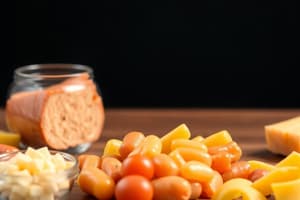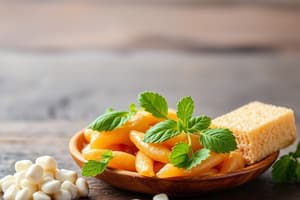Podcast
Questions and Answers
Where does the majority of protein digestion occur in the human body?
Where does the majority of protein digestion occur in the human body?
- Stomach
- Small intestine (correct)
- Liver
- Large intestine
Which type of protein is primarily found in connective tissues, hair, and nails?
Which type of protein is primarily found in connective tissues, hair, and nails?
- Soluble proteins
- Globular proteins
- Insoluble proteins
- Fibrous proteins (correct)
What is the main function of globular proteins?
What is the main function of globular proteins?
- Enzymatic activity (correct)
- Structural support
- Receptor binding
- Transport functions
From which of the following sources can one derive plant proteins?
From which of the following sources can one derive plant proteins?
Which type of proteins are embedded in cell membranes and involved in signaling and transport?
Which type of proteins are embedded in cell membranes and involved in signaling and transport?
How are proteins broken down to make them bioavailable for absorption and use by the body?
How are proteins broken down to make them bioavailable for absorption and use by the body?
What determines the unique three-dimensional structure of a protein?
What determines the unique three-dimensional structure of a protein?
Which level of protein structure involves the folding of secondary structures into three-dimensional shapes?
Which level of protein structure involves the folding of secondary structures into three-dimensional shapes?
In which capacity do proteins function as transporters within living organisms?
In which capacity do proteins function as transporters within living organisms?
What is the primary function of collagen in living organisms?
What is the primary function of collagen in living organisms?
Which type of protein structure involves the association of multiple polypeptide chains to form multimeric proteins?
Which type of protein structure involves the association of multiple polypeptide chains to form multimeric proteins?
What are proteins composed of?
What are proteins composed of?
Study Notes
Exploring Proteins: An Essential Biomolecule
Proteins are complex, versatile molecules that are central to the functioning of all living organisms. From the building blocks of cells and tissues to the catalysts of chemical reactions and the driving force behind movement, proteins play a critical role in our lives. Let's delve into the structure, functions, sources, and digestion of these indispensable biomolecules.
Structure
Proteins are composed of long chains of amino acids, which are linked together by peptide bonds. The sequence of amino acids in a protein determines its unique three-dimensional structure, ultimately defining its function. Protein structures can be classified into primary, secondary, tertiary, and quaternary levels. Primary structure represents the amino acid sequence, while secondary structure refers to the folding patterns that occur in the protein chain, such as alpha-helices and beta-sheets. Tertiary structure describes the folding of secondary structures into three-dimensional shapes, and quaternary structure relates to the association of multiple polypeptide chains to form multimeric proteins.
Functions
Proteins perform a wide variety of functions within living organisms. They act as structural components, such as collagen in connective tissues and keratin in hair and nails. Proteins also function as enzymes, catalyzing biochemical reactions. We rely on proteins as transporters, carrying substances across cell membranes and throughout the body. They also serve as receptors, binding to specific signaling molecules, and as antigens, eliciting immune responses.
Sources
Proteins are derived from various sources, including both animal and plant products. Animal proteins can be found in meat, poultry, fish, dairy products like milk, cheese, and yogurt, and eggs. Plant proteins are present in vegetables, legumes like beans and lentils, nuts, seeds, and whole grains like rice, quinoa, and oats. Protein supplements, such as protein powders and bars, are also available for those seeking to increase their protein intake.
Digestion
Proteins are broken down by the digestive system into their constituent amino acids, making them bioavailable for absorption and use by the body. The process begins in the stomach, where proteins are exposed to digestive enzymes like pepsin. The majority of protein digestion occurs in the small intestine, where additional enzymes like trypsin, chymotrypsin, and elastase are secreted by the pancreas to break down the proteins into smaller polypeptides. Peptidases, found on the surface of the intestinal cells, further cleave these polypeptides into individual amino acids, which are then absorbed into the bloodstream and transported to cells throughout the body.
Types
Proteins are often classified according to their structure, function, or chemical properties. Some common protein types include:
- Fibrous proteins: primarily structural, found in connective tissues, hair, and nails.
- Globular proteins: mainly enzymes, transporters, and receptors.
- Soluble proteins: found in watery environments, such as the cytoplasm of cells.
- Insoluble proteins: found in the membranes of cells and organelles.
- Membrane proteins: embedded in cell membranes and involved in signaling, transport, and other functions.
This brief overview of protein structure, functions, sources, digestion, and types provides a glimpse into the complex and diverse world of these biomolecules. As integral components of life, proteins are essential to the functioning of all living organisms.
Studying That Suits You
Use AI to generate personalized quizzes and flashcards to suit your learning preferences.
Description
Delve into the world of proteins, from their composition of amino acids to their crucial roles as structural components, enzymes, transporters, and receptors. Learn about protein sources from animal and plant products, and understand the process of protein digestion in the body. Explore different types of proteins, including fibrous, globular, soluble, insoluble, and membrane proteins.




